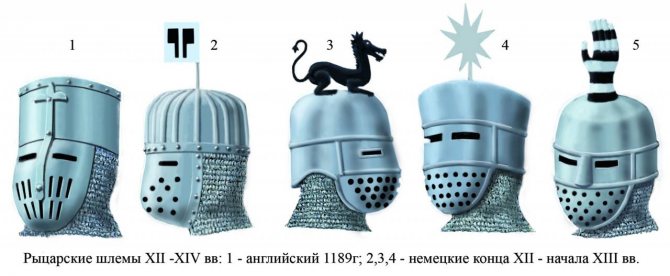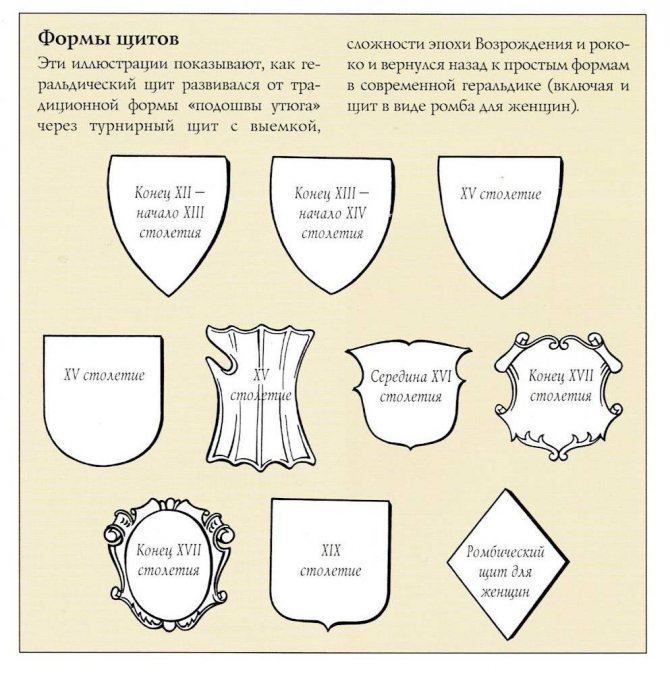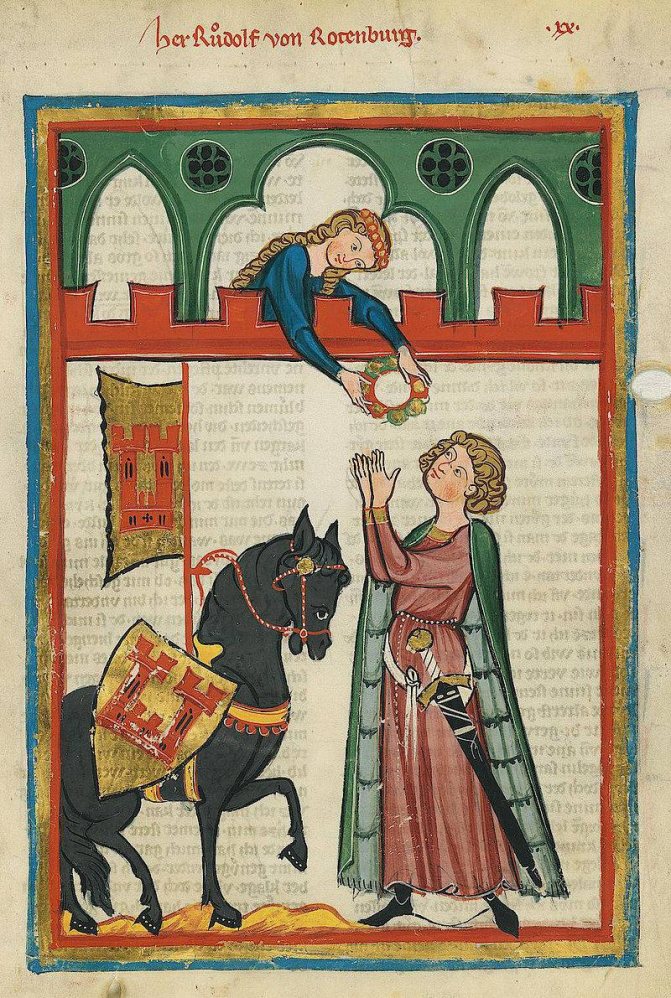Ares - Ares was the god of war, battles and victories in ancient Greece. A valiant warrior, he represented a very different side of war than his sister Athena. He was a fierce and passionate fighter. In Rome Ares was known as Mars. Ares was also worshipped there as the god of agriculture. Together with his beloved Aphrodite he gave birth to a galaxy of gods, including Eros. He is the son of Zeus and Hera (or Hera alone). The attributes of Ares (Mars) are known. For example, the spear and shield of the god Mars is a well-known combination of symbols used in many spheres.
What were the attributes of the god Ares
Whatever the sign of the god of war Ares was in Greek and Roman mythology, it was almost always an object associated with war, military actions and battles. God Ares was depicted accordingly - in full battle attire, shining gold armor, with weapons (shield, as well as a spear or sword). Ancient authors describe Mars as a strong young man. His whole appearance and attributes point to the military sphere.
The attributes of Ares and Mars, the god of war, were somewhat different in the Roman and Greek traditions. Thus, the Greeks had images of both the spear and the sword. In Rome, however, Mars always held only a spear, there was no sword.
The Greek Ares was not only the god of war and weapons. He even embodied these things, as you can see in various ancient texts. There the name of Ares can refer to weapons, describing how Ares thirsts for the blood of his enemies. Ares, as the god of war, was often attributed various phenomena of this sphere, so his functions were very diverse. Ares was the name of the war itself, Ares was also the name of the events taking place there, Ares could be the name of the bravery of the warriors.
Ares was the son of Zeus and Hera (in Ancient Rome - the gods Juno and Jupiter). But of all the gods he gained the least love from Zeus. It is well known what Zeus said to Ares, who had returned from the battlefield with wounds during the Trojan War. Zeus considers him treacherous. Zeus even threatens to throw Ares down from Olympus, even though Zeus himself and his father.
Mars in ancient Rome had another unusual function, also related to weapons. There, prayers were made to Ares for protection against rust. Both rust, which affects metal, and plant disease were meant. Metal could also serve as a material for both military weapons and agricultural materials. As a result, Mars also became the god of fertility. And Ares in Ancient Greece had no more agricultural features.
Crosses
The most important image on the shields of Christian warriors seemed to be that of the crosses. In Europe, where the crusades and the orders of the Hospitallers, Templars, Teutoners set a certain rhythm of life, the cross was popular.
In Russia, judging by the images - not so much. Here is the only image of the cross on the shield, which the editors of "Ludota" managed to find.
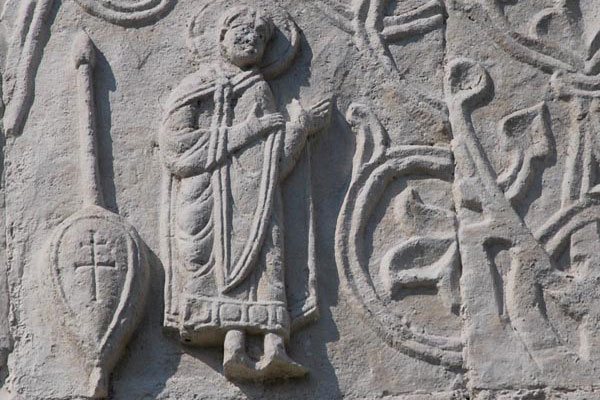
This is a stone carving on the temple of St. George the Victorious in Yuriev Polsky, one of the cities of Vladimir-Suzdal Russia. It is dated XII-XIII centuries.
"Polish", by the way, not because it is related to Poland, but because it is located in a field, if more precisely - in Suzdal Opolye.
The shield and spear of the god Mars
The most famous symbol of Mars, god of war, is a combination of his shield and spear.. Ares is the famous god of war, so he is unthinkable without the appropriate attributes. Both Mars among the Romans and Ares among the Greeks were always depicted as a stately, strong young man dressed in armor. The weapons used were a shield and a spear or a sword. The spear was more common than the sword. The shield and spear eventually became a single symbol that was popular in different eras.
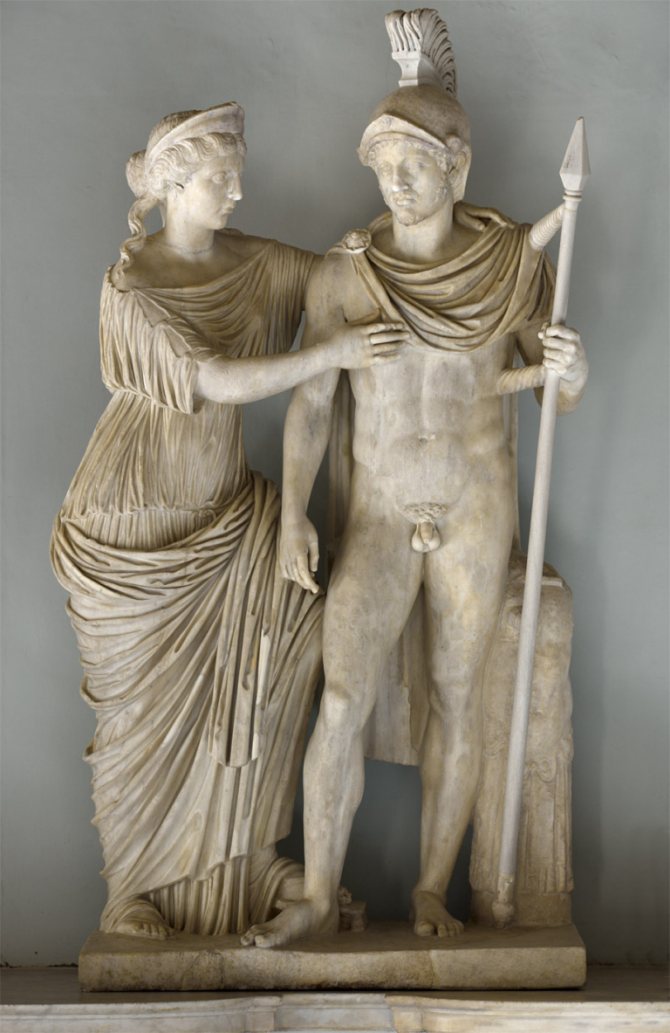

The sculptural group Mars and Venus. Capitol Museums, New Palace, Gallery. Rome.
The appearance of the shield and spear of Mars
Originally this emblem of the god Mars was a treasure that was kept by the Roman kings. And the spear had less significance than the shield. It was more of a mere weapon, as Ares has always represented the god of war and battle. The weapon represents his martial nature. The spear had more of an abstract meaning, it also showed itself as a symbol of male strength, of the male self.
And yet this symbol of the god Mars, i.e., the spear, was carefully kept by the Roman kings. It was placed in the regiaa building in the Roman forum, the main city square of Rome. The regia was used either as the residence of the Roman kings or as a place where they were perdently present. Later the building became the seat of the high priest (the great pontiff.).
But such attributes of the god of war Mars as his shields played a more important role. There were 12 of them, but 11 were copies of the original shield. In these legends, the very first shield of Ares fell from the sky and was given by the gods. It was able to be picked up by the king ruling at the time - the semi-legendary Numa Pompilius.. He ruled from 715 to 673/672 B.C. Pompilius dealt with the calendar and brought it into a more orderly form, established various collegia of citizens, and introduced some holidays.
When the shield of Mars ended up in the hands of the king, it was considered a good omen. The Romans decided that their state would always be victorious and that Roman kings would be rulers of the world. Besides, Numa Pompilius himself claimed that when the shield fell to him, he heard a loud voice shaking the sky. It was, apparently, the voice of Mars himself. Mars affirmed the invincibility of Rome as long as the heavenly dart was kept by its kings and citizens.
To protect this attribute of Mars, Pompilius ordered the creation of 11 copies of the shield.
As a result, all 12 shields - real and fake - were kept together. The king reckoned that if enemies broke into the regia, they would not be able to recognize the real Mars shield and steal it. The real artifact is called ankiland this name is still controversial in terms of its origin. In ancient times it was assumed that the source was a Greek word that was translated as "curved." In the ancient Greek writer Plutarch, ankyl meant "protection worn at the elbow," and the word was derived from the Greek "elbow."
Drawing of the ankylus.
The shield of Mars looked like an ellipse with notches around the edges. There were also various patterns on the surface. This shield did not become the official symbol of Rome, but still played an important iconic role:
- In March, when the Feast of Mars was celebrated, all 12 shields were carried through Rome in a solemn procession. They were carried by saliithe priests of the college, half of whose members belonged to the cult of Mars. The salies also carried the shield the rest of the time.
- Before going to war, the shield that Mars had bestowed on them, together with the spears, was used by the generals in rituals. They shook the weapons to attract victory.
- However, if the attributes suddenly moved themselves, ringing, it was regarded as a bad omen. It meant that war or other misfortune was coming soon.
- Since Ares and Mars were inextricably linked with weapons and were often depicted in Roman architecture, the shield of this god also became a separate architectural element. Anchilus was placed on a military armature, a decorative element in the form of weapons or other military equipment.
The Sword and Shield of Mars in the Middle Ages
Mars and his attributes remained known even after the Antiquity era. In particular, Mars, through his shield and spear, was immortalized in the Middle Ages, namely in the sixteenth century. It was then that the shield and spear of Mars acquired its current appearance.
During the Middle Ages a symbol appeared in which the spear passed through the shield, emerging from it with the shaft at one end and the point at the other. The spearhead points upward to the upper right corner.
The basis for this sign served as a tradition that originated in Antiquity. At that time, the god Mars was depicted as a spear. This again emphasizes his relationship with war and weapons.
In the Middle Ages, the spear of Mars primarily played the role of as an alchemical symbol.. It stood for one of the metals, namely iron. The alchemical symbol for iron, in turn, was associated with fire, the element that Mars was in charge of. This also includes the "red planet" - Mars.which is also associated with war, fire, harshness.


Meanings of the shield and spear of Mars
Other meanings of the spear of Mars
After the spear was used as a symbol of iron, it has undergone many more changes. The main ones concerned the transformation of the attribute into a personification of the male sex.
Mars and its attributes denoted masculine qualities - strength, aggressiveness, militancy, purposefulness, physicality. As a result, over time, the god Mars began to denote the masculine gender as well. The spear of Mars became a designation of masculinity in men. It also plays an important role in botany and biology. The opposite symbol was... the mirror of Venus. - the personification of the female sex.
The goddess of love Venus was the Roman equivalent of Aphrodite, the goddess of love. Her legitimate husband, Hephaestus, was worshipped as a blacksmith god. Aphrodite's lot was to give love and fall in love. The goddess became the mistress of Ares, by whom Aphrodite had several children. For example, the goddess Aphrodite gave birth to Eros. In the legends, Hephaestus catches the deceivers with a golden net. Afterwards, Hephaestus mocks Aphrodite and Ares.
The spear of Mars has also acquired the following meanings:
- In astrology and astronomy, the red planet Mars;
- in botany, one part of a flower (stamen);
- a group of males in insects that lead a social way of life;
- The spear acts as Volvo's logo; volvo is a company which has been making cars since 1927, the logo looks like a silver circle with a spear, inside is the white Volvo lettering on a blue background, resulting in a masculine image which denotes reliability (silver) and sophistication, originality (blue).
What kind of science is this?
Despite the intricate name, the essence of the science is quite simple. Heraldry studies the meaning of symbols and colors used to create a coat of arms. This kind of knowledge at first glance may seem useless, but do not jump to conclusions.


Heraldry originated during the Crusades, and over time absorbed many of the traditions of chivalry, reflecting the life and culture of feudal Europe.
A coat of arms can tell a lot about its owner: strengths and weaknesses, a motto, his credo and even social status. All that is needed to understand all this is just to refer to the knowledge accumulated over many centuries of study.
The Spear of Ares in Greek Mythology
The spear, a symbol of Ares, the god of war, played a major role in Greek mythology as well. There it appeared on a par with the sword, but it was the spear that was mentioned more often. The ancient authors describe the power of this weapon, how formidable and deadly it was.
The way Ares fights with a spear is first of all mentioned in "Homer's Iliad.. Ares plays with the spear in a furious battle, it is huge and made of bronze. In fact, of all those present at the Trojan War, only the goddess Athena was able to remove the hand of Ares. Athena is the sister of Ares, also the patroness of battles. Athena represented the battle for peace and tranquility.
The spear that Ares holds is sometimes compared to fire, it blazes and brings fear.
The armor of the god Ares
Armorthat Ares wore, was also an important attribute of his. In ancient texts Ares was described shining as if enveloped in fire. His armor, too, shone and was made of gold. Sometimes it is said that they are forged of bronze.
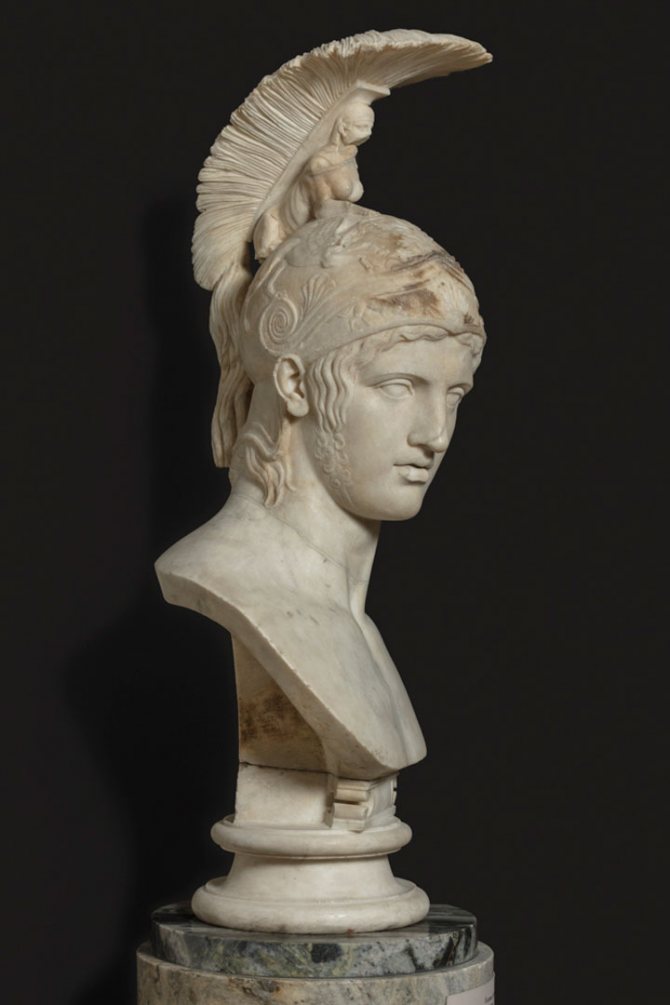

Bust of Ares. State Hermitage Museum, St. Petersburg.
Ares wore the following elements of military attire:
- a cuirass (armor that was worn on the body and consisted of plates for the chest and back);
- greaves (to protect the front part of the legs);
- combat belt;
- helmet with a comb.
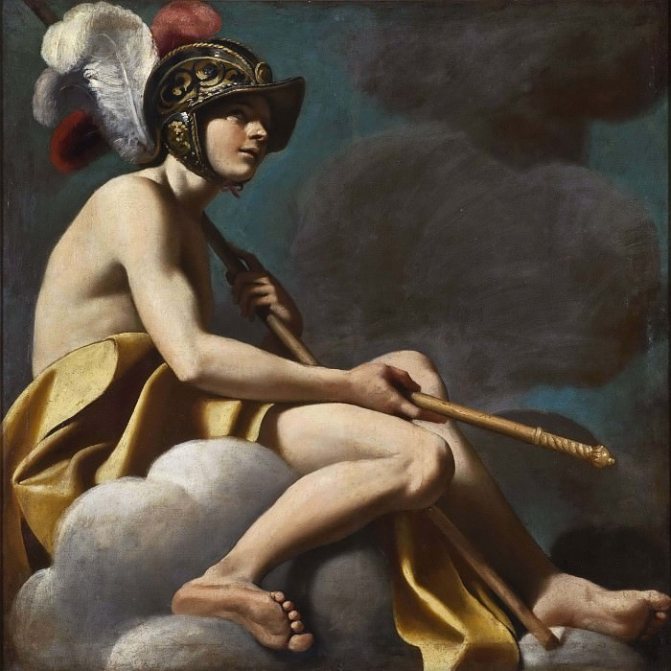

Mars. National Museum, Stockholm.
Other attributes of Ares.
Other symbols of Ares have also been associated with war in one way or another. For example, his chariotin which the god went off to battle. It shone like Ares' armour and the reins were made of gold. The chariot was harnessed ...with four horses that breathed fire.... Sometimes the charioteers are the sons of the god of war - Phobos (fear) and Deimos (terror), his children from the goddess Aphrodite, who helped Ares on the battlefield.
The flaming torch is also often mentioned. It was used by the priests of Ares to signal the start of a battle between armies.
The dominion of Mars. National Gallery of Art, Washington, DC.
Significance of color.
It is not difficult to guess that even the smallest, seemingly insignificant detail, without which the meaning of the heraldic symbol would change fundamentally, is important in the execution of a coat of arms. Heraldry considers the meaning of symbols and colors both in the aggregate and separately from each other. It can be assumed that only the very first images, which began to be placed on flags and armor, were of a casual nature. However, during the Middle Ages, when a widespread passion for the mystical features of those or other phenomena and beings, when people tried to discern the hidden meaning and a certain divine revelation in the world around them, symbols and colors began to be given special significance.
The significance of colors in heraldry is especially great because it is the colors that are the first to be noticed. Besides, the color additionally characterizes the owner of the coat of arms. Seven colors are used in heraldry: two metals and five enamels. Initially only four colors were used, but over time the palette expanded by mixing colors. A separate type of heraldic colors are furs - ermine and squirrel.
So, let's consider the basic meaning of colors in heraldry.
The sword of Mars
Ares was known not only in Rome and Greece, but also among other peoples. For example, it was worshipped by the nomadic tribe of the HunsThe tribe lived in Central Asia, the Caucasus and Eastern Europe. Scientists came to this conclusion first of all because of an unusual artifact called the Sword of Mars or Sword of the God.. The sword of the god Ares was in the possession of Attila, the legendary king of the Huns..
Attila ruled from 434-453. Attila was known for his unification of tribes and his numerous campaigns. It is known that Attila, king of the Huns, undertook campaigns to Byzantium and Italy. As a result, Attila created a huge power. The area where Attila ruled stretched from the Rhine to the Volga River. Attila entered the legends of the Scandinavians. It was written about him that Attila earned his fame. Attila was honored by many legends, one of them concerning his sword. It was said that Attila received it from the gods.
The sword of Mars (Attila) is also the main evidence that Ares was accepted and revered by the Huns. The account of where the sword came from and how it got to Attila is in the Gothic story by Jordan.. He in turn took material and information about how the sword came to be from the late antique historian Priscus of Panile.. In any case, in all the stories the sword is of divine origin.
Attila's sword was found by a shepherd when he went to fetch a wounded cow. He dug up the sword, which had been trampled into the ground, and took it to Attila. Attila immediately took the sword as a sign that Attila was now the ruler of the world. This sword gave him the right to conquer all countries.
As a result, Attila, king of the Huns, used the sword both as a weapon and as a symbol that the sword was granted by the gods, a blessing to the ruler. Moreover, Attila used the sword in a way that demonstrated his power - and ultimately confirmed that Attila's sword was of divine origin.
Attila also turned the sword into something like a scepter. The sword became a symbol of the power of Attila the Hun king and his invincibility.
In the eleventh century a sword was found which could have been Attila's sword. However, this sword was most likely created by Hungarian kings of the Arpadov dynasty.. They believed that Attila was their ancestor, and the sword confirmed the right to power.
Still, most researchers believe that the "sword of Attila" was created in the 10th century and is not really a sword of Attila as such. The sword is now housed in the Kunsthistorisches Museum in Vienna.
Heraldic flora
Plants in heraldry have no less importance than animal images. The use of various plants in heraldry has a long history. The most common image among plants is the symbol of the rose. The queen of flowers often occupies a place of honor on the coats of arms of various noble families. According to the laws of heraldry, only members of the royal family can afford to decorate their coat of arms with a wreath or garland of roses. Another popular symbol of plant origin is the lily. It symbolizes purity, sanctity, and chastity.
Figures of fantastic animals, as a rule, were borrowed from folklore or mythology.
Among this kind of images are most often found on the coats of arms griffins, phoenix, mermaid, famous basiliski, of course, Pegasus. The fire-breathing dragons were also present.
It would be wrong to claim that only fantastic creatures were used in heraldry. Eagles, antelopes, horses and salamanders, panthers and deer, wolves and lions were often found on the coats of arms of houses and states.

